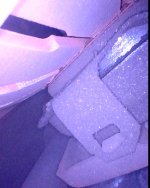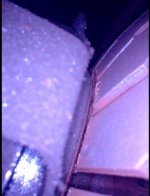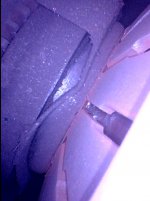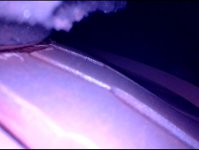You did it right Jock by bleeding the system first, so I don't really understand why you jumped to the master cylinder job, which by the way is describbed in eLearn as a "funny" one ! (2nd lesson: RTFM first)
Best regards, Bernie.
Thanks very much for the kind words Bernie - much appreciated.
So, for your delectation, my diagnostic thought processes went something like this:-
1) Poor soft feeling pedal with long throw before anything happens - Simple, felt it many times before, probably air in the system so bleed it out. Of course if that had resulted in a much improved pedal then an investigation would need to be made into where the air was getting in! I last drove the car around 9 months previously and it had been fine then.
2) Surprisingly absolutely no change in pedal action at all! What's going on? Ok, complete examination of system undertaken. No leaks on pipework anywhere and all pipes look fine. Next crawl about in the drivers footwell with a very bright Cree lamp to examine the back end of the master cylinder and push rod/pedal etc. All ok not the slightest sign of physical damage or leaking fluid. So onwards to the slave cylinder. Pulled back the convoluted gator. Nice and clean looking but a very very small dampness is noticed - nothing you could call a leak though. No actual liquid fluid running about. Next got Mrs J to operate the pedal whist I observed then compared to our 1.2 Panda and it's immediately obvious that the Punto's cylinder stroke is noticeably shorter than the Panda. The setup is virtually identical on these two cars so I just knew this wasn't right. At this point perhaps I should have tried clamping off the flex hose and seeing how the pedal behaved. If it had given a good "hard" pedal it might have stopped me going of at a tangent suspecting the "thingy" (still want to know what it does and how it works) but I'm not sure if it would prove there still wasn't a problem related to the performance of the m/cyl over the full length of it's stroke - for instance if there was a problem with the relationship of seals to recuperating port etc?
3) So now we come to my dodgy conclusions. It has to be said that renewing the clutch itself was not helpful in diagnosing anything to do with the actuating mechanism. I was just "lucky" to find that the clutch was actually well worn (deeply grooved ends on the diaphragm fingers where the release bearing makes contact and a driven plate which was near the end of it's life. It would have required replacing soon but had no impact at this time on clutch operation. Anyway, given that replacing the actual clutch itself was a red herring in terms of diagnosing the actuation problem, My reasoning went: a) All bled through and no air expelled after running maybe 2/3 of a litre of fluid through. b) No leaks of any consequence and no physical damage observed anywhere. c) Slave cylinder "throw" and thus release lever movement much reduced although the pedal/master cylinder is moving over it's full stroke (ie nothing, like mats, carpets, etc limiting pedal throw.
Just has to be something obscure gone wrong inside the master cylinder doesn't it? better renew the master cylinder.
So that was my thinking. I'm a little consoled by the fact that having failed to manage to fit the master cylinder and handing it over to the garage who did a splendid job but still ended up with no improvement, - remember this was before the clutch itself was replaced - They then reached the conclusion, after working on it and subsequently power bleeding it with no improvement at all, that it was probably the clutch itself at fault. So they themselves did not suspect the slave at that time. Even now, with the old slave cylinder sitting on my workbench with it's gator pulled back, I can still actually see no reason as to why it was behaving as it was.
Ah well, You learn a little every day. Eh?
Stay safe all you lovely people
Jock.






